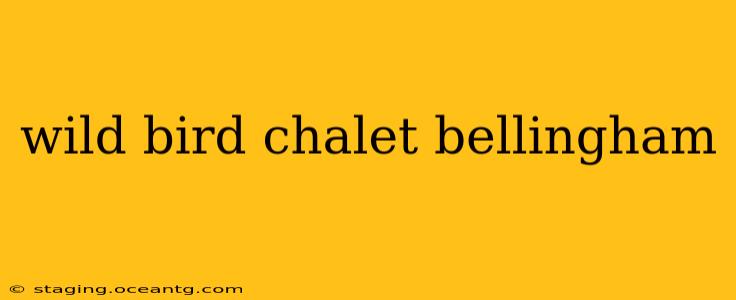Bellingham, Washington, boasts a rich biodiversity, making it a haven for bird enthusiasts. Among the many opportunities to observe avian wonders, the Wild Bird Chalet stands out as a unique and engaging experience. This isn't your typical bird sanctuary; it's a carefully curated environment designed to bring you closer to nature's feathered friends. This guide dives deep into what makes the Wild Bird Chalet so special, addressing common questions and providing insider tips for your visit.
What is the Wild Bird Chalet in Bellingham?
The Wild Bird Chalet in Bellingham isn't just a place to see birds; it's a place to connect with them. It's a meticulously designed habitat focusing on providing a safe and enriching environment for a variety of bird species, allowing for close-up observations without disturbing their natural behaviors. Think of it as a luxurious, avian-centric hotel, complete with specialized feeders, bathing areas, and strategically placed observation points. While specific details about its exact location and setup may not be widely publicized to protect the birds, its unique approach to birdwatching makes it a memorable experience.
What kinds of birds can I see at the Wild Bird Chalet?
The specific birds you'll encounter at the Wild Bird Chalet will vary depending on the season and local migration patterns. However, given Bellingham's location, expect to see a diverse array of species, including many common backyard birds like chickadees, juncos, and woodpeckers. You might even catch a glimpse of more uncommon visitors, adding to the thrill of birdwatching. The Chalet's design likely attracts a wider range of species due to the abundance of food and water sources provided.
Is the Wild Bird Chalet open to the public?
The accessibility of the Wild Bird Chalet to the public is likely restricted. Preserving the natural habitat and minimizing disruption to the birds is paramount. Information regarding tours or public access should be sought through local birdwatching organizations or nature centers in the Bellingham area. They might offer guided tours or workshops that include a visit to similar locations or provide valuable insight into birdwatching spots within Bellingham.
What makes the Wild Bird Chalet unique?
The Wild Bird Chalet distinguishes itself through its commitment to creating an enriching environment for the birds while providing an exceptional viewing experience for visitors. Unlike some bird sanctuaries that focus solely on preservation, the Chalet seems to prioritize facilitating close encounters with nature while maintaining the welfare of the birds. This careful balance is what sets it apart. The exact details of this unique approach might not be widely publicized to maintain the birds' well-being.
How much does it cost to visit the Wild Bird Chalet?
As the specifics about access and tours aren't publicly available, there's no readily available information on the cost of a visit. It’s advisable to contact local birdwatching groups or nature centers in Bellingham for potential guided tours that might include the Chalet as part of their itinerary. The cost, if any, would likely be associated with the guided tour itself.
Where can I find more information about the Wild Bird Chalet?
Since details surrounding the Wild Bird Chalet are limited, further information may be difficult to find through conventional online searches. Your best bet would be to connect with local birdwatching enthusiasts or groups in the Bellingham area. They might have insider knowledge of the Chalet and could potentially offer opportunities to visit or learn more about similar bird-watching experiences in the region.
Note: The information provided above is based on the limited public information currently available. The exact nature and accessibility of the Wild Bird Chalet remains somewhat elusive, emphasizing the importance of contacting local organizations for further details. This reinforces the need for responsible and respectful birdwatching practices, focusing on minimizing disruption to wildlife and their natural habitats.
